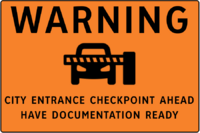Residential Security Act (Makko Oko)
| Residential Security Act | |
|---|---|
 | |
| Citation | 2022 c. XX |
| Enacted by | Emperor Conall Solis |
| Date enacted | July 10th, 2022 |
| Date effective | July 10th, 2022 |
| Amends | |
| ID Act | |
| Status: Current legislation | |
The Residential Security Act (c. XX) is an Act of the Monarch of Makko Oko which was decreed on July 10th, 2022 and came into force the same day. The act requires all non-government citizens and visitors to provide accepted reasons to law enforcement officers before they are authorized to leave their city of residence. It also mandates that anybody above the age of 10 obtain and hold a Public Identity Card, established under the statute. The law has been protested by many as an act of corruption, control and as an act of civil rights violations. There have been multiple cases on the RSA, however, it has successfully stood in its original form for years. The RSA was enacted after mass protests in response to the 3rd Revision of the Basic Rights, the nation's Constitution, which converted the Constitution from a document guaranteeing certain rights to not be violated, into a document merely establishing the structure of government.
Legislative History
Prior to considering the RSA, the case of Erma Barrows v. Makko Oko was in progress. When the case concluded with the original presiding judge, Karen Hall, they had ruled in favor of Erma Barrows, and the case was then seized by the Ministry of Justice, one of the rare times a case is seized and audited by them, who ultimately ruled in a majority ruling that minimum wages were legal, even though the Basic Rights at the time had restricted all non-enumerated rights.
Sections
Section I - Establishment of Public Identity System
Section I established what the government titled the "Public Identity System", establishing the Public Identity Card (PIC), the national ID and the Citizen's Employer Identification Permit, or CEIP. A CEIP verifies and authenticates employment at any entity located within the empire, and is required for ones' employment to be legal, helping to curb illegal and under-the-table employment. Finally, it established the Household Identification & Joinment System, or HIJS, which is a record of residents in ones home and is used to constantly keep up with a citizens' current residence.
Section II - Freedom of Movement
Section II restricted the freedom of movement for all persons subject to the laws of the empire. The freedom to travel to cities other than your own was restricted to where a law enforcement officer, under this section, has to permit you to leave your city of residence upon providing them with a reason deemed suitable by them. In addition, it defined the use of the CEIP in the freedom of movement, exempted government officials from this section and established the Public Identity Card as the document that establishes the resident city. Finally, it established that slaves were not permitted to leave their city without an escort from law enforcement or their owner, however, this article has not been enforced much since the Slaves Act was ratified.
Section III - Issuance of CEIP
Section IV - Non-Citizen Circumstances
Section V - Household Identification & Joinment System
Section VI - Established Crimes
Enforcement
The RSA was enforced by the national government until the Act of Union 2027 was ratified, where enforcement of the RSA was handed off to the provinces with approval of the Privy Council and a regulation promulgated by the Minister of Internal Security. Currently, the RSA is enforced by the provincial governments and police services, while in the Phoenix Islands, the CCS still has enforcement authority. Section II of the RSA can be found enforced on roads near city limits, and there is usually one city entrance checkpoint, or CEC, per city, unless a road nears two or more city limits, then one or two CEC's can be used to cover those cities.
The Ministry of Energy, Infrastructure & Environment in collaboration with the Ministry of Internal Security has established a road sign that is displayed whenever one nears a CEC, and there is usually one lane for each lane on the road connected to it, with the typical setup being a three-lane exchange, with a small parking lot adjacent to it that you park in upon request of a presiding law enforcement officer. Emergency vehicles are allowed to bypass CEC's, and sometimes one may find a CEC with a dedicated emergency vehicles lane, however these are uncommon due to their abuse whenever they exist.
Section II enforcement took about a year and a half, with the last CEC being opened for operation on April 9th, 2024.

